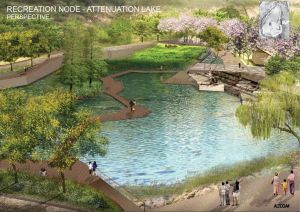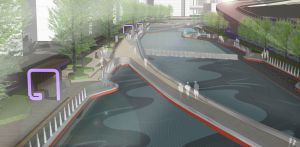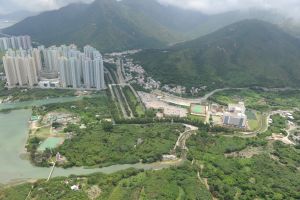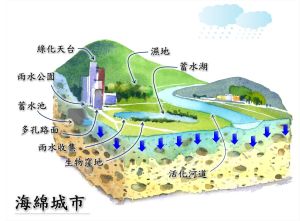Review of Total Water Management Strategy
|
Many places in the world are facing the problem of tight water resources. The situation has been aggravated by climate change as well as unpredictable droughts and floods in recent years. In this regard, the Hong Kong SAR Government has been devising long-term planning for future water resources management to meet the challenges posed by climate change. Recently, members of the Legislative Council Panel on Development have also put forward some recommendations for Hong Kong after visiting a desalination plant in Singapore and studying the country's strategies and experiences on water resources management. To give you a more comprehensive understanding of the issue, let me here provide a brief introduction of our total water management strategy and related measures.
The Government promulgated the Total Water Management (TWM) Strategy in 2008, putting emphasis on containing growth of water demand by promoting water conservation through public campaigns and education. On the supply front, apart from rainwater, Dongjiang water and seawater for flushing, we have been actively exploring new sources of water supply including seawater desalination, water reclamation and grey water recycling/rainwater harvesting. We started a review of the TWM Strategy in 2014 covering an assessment of the long-term water demand and supply for the period up to 2040, with a view to establishing reasonable proportions of the above-mentioned six water supply sources, enabling us to better prepare for the various challenges brought about by climate change. We expect the review to be completed next year. In terms of reclaimed water, the Government, after conducting technical and cost-effectivness studies, is planning to further process the effluent from the Shek Wu Hui Sewage Treatment Works to produce reclaimed water for flushing and other non-potable uses in the northeast area of the New Territories (including Fanling and Sheung Shui). We have commenced the design and launched studies in respect of the finance and legal framework. We expect the reclaimed water supply to be available in phases starting with Sheung Shui and Fanling from 2022 onwards. The WSD will continue to study the feasibility of introducing reclaimed water in other areas without seawater for flushing. In addition, the Government plans to include grey water recycling and rainwater harvesting systems for non-potable uses in suitable new public works projects. So far, grey water recycling systems or rainwater harvesting systems have been introduced to over 50 works projects including schools and various government facilities. When planning large-scale new development projects such as the Anderson Road Quarry site development, we will reserve space and ancillary facilities for introducing grey water recycling and rainwater harvesting in future as appropriate if feasible. In recent years, some legislators have suggested that the Government should make use of drainage tunnels to intercept rainwater or expand catchment areas. In fact, we studied various options of rainwater re-use some years ago when planning the Tsuen Wan, Lai Chi Kok and Hong Kong West Drainage Tunnels. I must point out that, unlike rainwater collected in reservoirs, rainwater running through roads in developed areas and on the surfaces of buildings would be contaminated by exhaust gases from vehicles, grease, bird droppings, litter or other pollutants. To safeguard public hygiene and health, such rainwater must be properly treated before public use. Previous research concluded that all re-use options would require huge capital investment for appropriate treatment, construction of additional tunnels, pipelines and pumping facilities, etc., and thus would not be cost-effective. However, the relevant cost data and technologies may be different nowadays. We hence keep an open mind to review various options of rainwater re-use through rainwater drainage tunnels and stormwater storage schemes. At present, the local catchment areas measure 300 square kilometres, accounting for about 30 per cent of Hong Kong’s total area. In view of the land shortage in Hong Kong, the suggestion of further expanding the catchment areas is not quite feasible. Quite a number of legislators suggested that the Government could make reference to the Active, Beautiful, Clean Waters (ABC Waters) Programme of Singapore and revitalise water bodies such as waterways, nullahs and reservoirs for public enjoyment. In fact, the Chief Executive already proposed in the Policy Address last year to adopt the concept of revitalising water bodies in large-scale drainage improvement works and promote a water-friendly culture. The Government is currently working on three major projects of revitalising water bodies, namely the river park at Tung Chung River, the flood retention lake under the Anderson Road Quarry site development and the revitalisation of Tsui Ping River, Kwun Tong. We will carry out greening works on these stormwater drainage and storage facilities and reconstruct natural habitats, so that the public can enjoy the facilities and water-friendly activities with safety ensured. Meanwhile, the Drainage Services Department (DSD) has been adopting the “sponge city” concept in drainage management – that is to follow the nature with flexibility and to use green roofs and porous pavements to facilitate rainwater infiltration and reduce surface runoffs. We will keep an open mind and listen humbly to suggestions from the public regarding the expansion and optimisation of water resources. Also, we have responsibility to develop our own water sources amid threats posed by extreme weather resulting from climate change and the growing demand for Dongjiang water from different areas in Guangdong Province. Nevertheless, I noted that some political views have unnecessarily mixed into discussions in society on the issue in recent years. I find it neither helpful in our objective studies of the technical feasibility, cost effectiveness as well as the pros and cons of different water supply plans, nor enlightening in providing a solution to the political bickering that our society is facing. I hope that we can continue to explore the city’s water management strategy in a pragmatic manner and eventually come up with the best combination and proportions of water sources that suit the city’s actual circumstances. |
|
17 April, 2016
Back



